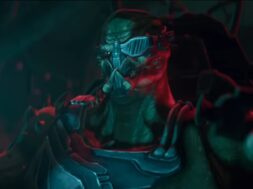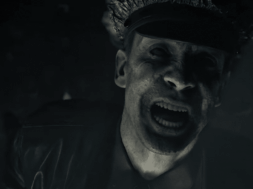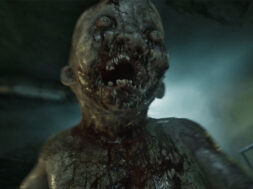Very few horror franchises manage to retain consistency throughout. Writers and directors change, usually altering continuity and mythos in the process. On-screen, the torch between protagonists often passes between sequels, and dialogue-free movie monsters aren’t exactly bound to the actor or stunt person portraying them. But all three entries in the Maniac Cop trilogy were penned by Larry Cohen, directed by William Lustig, and star Robert Z’Dar as the titular maniac cop, undead Officer Matthew Cordell. And it goes a long way in making this one of the best, if not underappreciated, horror trilogies to emerge from the late ’80s/early ’90s.
There are zero pretenses about a film titled Maniac Cop with a tagline, “You have the right to remain silent. Forever.” You know precisely the type of over the top fun you signed up for when you hit play. The idea came from maverick filmmaker Larry Cohen (The Stuff, It’s Alive), who was interested in creating a slasher that was lighter and more fun than mean-spirited gory horror tended to be. He wanted his slasher to have more intelligent characters, too. Most of all, he wanted to center it around a cop. Cohen enlisted Lustig, who instantly became amused by Cohen’s script and needed career redemption after the critical lashing Maniac took. Lustig’s eye for violence and bloodshed, with Cohen’s wry sense of humor, created a perfect pairing for an atypical action-horror slasher. Throw in a great cast stacked with horror stalwarts, and Maniac Cop became something special.

Set in New York City, Maniac Cop opens to a waitress walking home from her shift, where two muggers assault her. Relief punctuates a tense chase scene when the woman bumps into an unseen officer, the implication that he’ll save her from her attackers. Instead, he snaps her neck. It’s the start of a rash of murders committed by a murderer in a police uniform, which in turn causes innocent police officers to get gunned down by paranoid civilians. When Officer Jack Forrest (Bruce Campbell) is caught having an affair with fellow officer Theresa Mallory (Laurene Landon), and his wife winds up slain, Jack becomes prime suspect number one. Detective Lieutenant Frank McCrae (Tom Atkins) has been assigned to crack the case, and he quickly realizes there’s far more going on than meets the eye.
Aside from an unstoppable killer that slays anyone in his path, there’s very little else that resembles a typical slasher here. That’s a great thing, considering the peak slasher craze died years before. The protagonists are all adults, many of whom live messy lives. Jack and Theresa are tough and likable, but, interestingly, our introduction to these lovers are as adulterers getting caught in bed. Atkins plays a hardened detective with the mental fortitude we expect from the actor, and his casting proves to be all the more brilliant in the way he’s unceremoniously tossed out a window at a little over the halfway mark. You expect Tom Atkins to survive to the end credits, giving the film its first major shock.
A once-respected policeman with a penchant for brutality and excessive force, Matt Cordell found himself an unwitting target when stumbling upon City Hall corruption. It landed him in prison, where he was attacked by prisoners and presumed dead. His attempt at vengeance in the first film fails. Jack clears his name, and the maniac cop is left to a watery grave. It may conclude in traditional slasher fashion, but nothing about the first two-thirds’ procedural crime thriller plays like one.

In Maniac Cop 2, released direct-to-video two years later, Lustig and Cohen waste no time killing off previous hero Jack Forrest. Theresa Mallory outlasts only a little longer, just enough to have an epic battle with the revived and more decayed Cordell and pass the protagonist torch to Officer Susan Riley (Claudia Christian). Opposite her is Lieutenant Sean McKinney (Robert Davi), the best shot at clearing Cordell’s name.
As the best sequels do, Maniac Cop 2 expands on the mythos, ups the ante on the action, and even dives into the arena of exploitation. It doubles up on the villains, too; Cordell teams up and uses serial strangler Steven Turkell (Leo Rossi) as a pawn in his quest for revenge. Part two ends grants a satisfying conclusion, exposing the truth behind Cordell’s death and allowing him to be buried with full honors.
The finality of Cordell’s storyline didn’t stop another sequel from arriving in 1993. Reviving the maniac cop for the third entry proved tumultuous. By the third outing, Lustig was spent creatively on the franchise but was contractually obligated to direct. Adding fuel to the fire were the constant rewrites to Cohen’s script by producer Joel Soisson (A Nightmare on Elm Street 2: Freddy’s Revenge, The Prophecy) and uncertain casting- Davi didn’t agree to sign on to the feature until two weeks before shooting began.
Maniac Cop III: Badge of Silence took on a strange Bride of Frankenstein turn for Matthew Cordell, who’s resurrected by a voodoo priest as a pawn but winds up falling in love with comatose Officer Katie Sullivan (Gretchen Becker) instead. Sullivan became the fall guy for bad press in a shootout, and returning player McKinney is desperate to find the truth. It puts him in Cordell’s crosshairs once again. Look for Jackie Earle Haley as deranged criminal Frank Jessup to complicate things.

Maniac Cop III, aside from the bizarre inclusion of a voodoo priest, marks the first time Cordell slays actual bad guys. Up until this point, his victims have been innocent civilians and fellow officers. The trademark shocking death of a lead doesn’t happen here, either. It does, however, feature plenty of explosions and fire- with maniac cop essentially repeating his demise from the previous film- and Lustig’s trademark violence. Truly, Lustig knows how to make gunshot wounds pack a gory punch on camera. The climactic third act offers plenty of action thrills, too—all of which to say that it’s not all bad. At least not nearly as bad as its reputation suggests. But the tension behind the camera does spill onto the screen.
After turning in his rough cut, which clocked in under an hour, Lustig walked away from the project. Soisson picked up the reins and filled in the rest of the film’s footage, and Lustig effectively disowned the project by having the director credited as Alan Smithee. There’s enough of Lustig’s blueprint on the final film to keep it consistent, at least on an action basis, even if it’s a weak conclusion to the trilogy.
Overall, the Maniac Cop films offer a change of pace in the action-horror realm. Violence, bloodshed, unintentionally timeless themes, shocking deaths, and an insane roster of talent on screen. Aside from the leads, you can spot cameos throughout by Sam Raimi, Danny Trejo, Ted Raimi, Dan Hicks, Robert Forster, and Lustig himself. Z’Dar shapes Cordell into a horror villain that exists in the middle of Jason Voorhees’ silent stoicism and the boisterous personality of Freddy Krueger.
With a new series in the works based on the original film by Nicolas Winding Refn (Drive) and John Hyams (Universal Soldier: Day of Reckoning) for HBO, now’s the perfect time to catch up with the trilogy. Even better, they’re all available to stream on Shudder.










